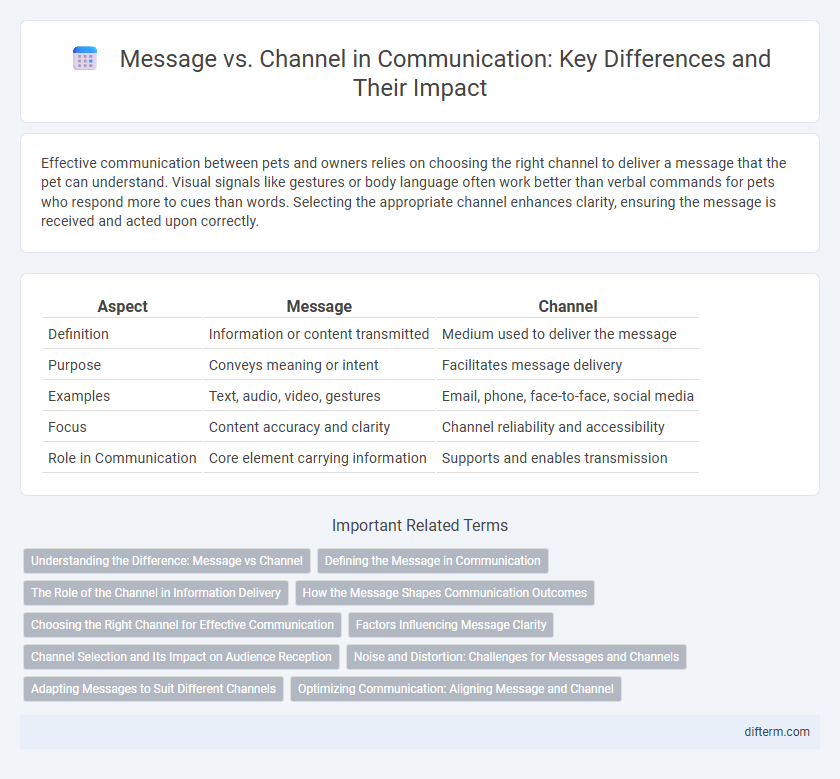Effective communication between pets and owners relies on choosing the right channel to deliver a message that the pet can understand. Visual signals like gestures or body language often work better than verbal commands for pets who respond more to cues than words. Selecting the appropriate channel enhances clarity, ensuring the message is received and acted upon correctly.
Table of Comparison
| Aspect | Message | Channel |
|---|---|---|
| Definition | Information or content transmitted | Medium used to deliver the message |
| Purpose | Conveys meaning or intent | Facilitates message delivery |
| Examples | Text, audio, video, gestures | Email, phone, face-to-face, social media |
| Focus | Content accuracy and clarity | Channel reliability and accessibility |
| Role in Communication | Core element carrying information | Supports and enables transmission |
Understanding the Difference: Message vs Channel
Understanding the difference between message and channel is crucial in communication. A message is the core information or content that the sender wants to convey, while the channel is the medium or method used to transmit that message, such as email, phone, or face-to-face conversation. Effective communication depends on selecting the appropriate channel to ensure the message is delivered clearly and received accurately.
Defining the Message in Communication
Defining the message in communication involves clearly identifying the core idea or information intended to be conveyed, ensuring it is tailored to the audience's needs and context. The message must be concise, coherent, and structured to minimize misunderstandings and maximize impact. Effective message definition enhances clarity before choosing the appropriate communication channel to deliver it.
The Role of the Channel in Information Delivery
The channel plays a crucial role in determining how effectively a message is conveyed and received, impacting clarity and engagement. Choosing the appropriate channel, whether digital, face-to-face, or written, ensures the message reaches the target audience with minimal distortion. Optimal channel selection enhances information absorption and facilitates timely feedback, essential for successful communication.
How the Message Shapes Communication Outcomes
The clarity and relevance of a message critically determine communication outcomes by influencing audience perception and engagement levels. A well-crafted message adapts to the receiver's cultural context and cognitive frameworks, enhancing understanding and reducing misinterpretation. Effective messaging drives emotional impact, builds trust, and fosters stronger relational connections regardless of the communication channel used.
Choosing the Right Channel for Effective Communication
Selecting the appropriate communication channel significantly impacts message clarity and audience engagement, with options ranging from face-to-face conversations, emails, and video calls to social media platforms. Consider factors like the message's complexity, urgency, and formality to ensure optimal channel effectiveness. Organizations enhance information retention and reduce misunderstandings by aligning channel choice with the communication purpose and audience preferences.
Factors Influencing Message Clarity
Message clarity is influenced by factors such as the sender's language proficiency, message complexity, and the receiver's familiarity with the subject matter. Choosing an appropriate communication channel, whether verbal, written, or digital, impacts how effectively the message is decoded. Environmental noise and feedback mechanisms also play critical roles in ensuring the intended meaning is accurately conveyed.
Channel Selection and Its Impact on Audience Reception
Channel selection profoundly impacts audience reception by determining the clarity, reach, and engagement of the message. Choosing the appropriate channel--whether digital platforms, face-to-face interaction, or print media--ensures the message aligns with audience preferences and context, enhancing comprehension and response rates. Analyzing channel characteristics such as immediacy, richness, and accessibility optimizes communication effectiveness and minimizes misinterpretation.
Noise and Distortion: Challenges for Messages and Channels
Noise and distortion significantly impact the clarity and effectiveness of messages transmitted through communication channels. Environmental noise, technical interference, and psychological distractions degrade message quality, leading to misinterpretation and loss of information. Overcoming these challenges requires selecting appropriate channels with robust encoding and decoding processes to ensure message integrity.
Adapting Messages to Suit Different Channels
Adapting messages to suit different communication channels enhances clarity and audience engagement by tailoring content to platform-specific characteristics such as tone, length, and format. For instance, concise, visually-driven messages perform better on social media, while detailed, formal content suits email or official reports. Understanding channel preferences and user behavior ensures effective transmission and reception of the intended message.
Optimizing Communication: Aligning Message and Channel
Optimizing communication requires aligning the message with the most effective channel to enhance clarity and engagement. Selecting channels based on message complexity, urgency, and audience preferences ensures the intended meaning is preserved and received promptly. Tailoring both content and delivery method reduces miscommunication and maximizes impact across digital platforms, face-to-face interactions, and written correspondence.
message vs channel Infographic

 difterm.com
difterm.com